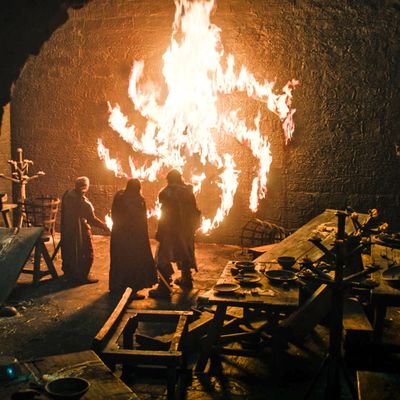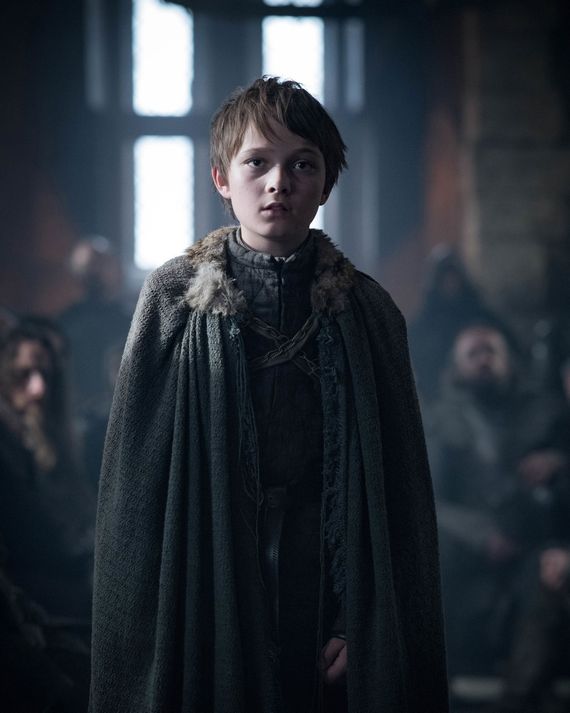
The screaming started before I realized what was wrong.
I’m at Radio City Music Hall, surrounded by thousands of nattily attired critics, HBO employees, and cast members both living and dead (fictionally speaking) for the world premiere of Game of Thrones season eight. By this point we’ve all sat together and watched around 50 minutes of wish fulfillment. From Jon Snow and Daenerys Targaryen going on a dragon-ride date to Arya Stark meeting her old friends (if that’s how you describe your first crush and a dude you left for dead) Gendry and the Hound, it’s been one of the most fan-friendly, and just plain friendly, GOT episodes ever made.
Are things starting to get a little spooky, what with Tormund Giantsbane and Beric Dondarrion and “Dolorous” Edd Tollett traipsing around an abandoned and quite possibly zombie-haunted castle by torchlight? Yeah, sure, but it’s nothing we can’t …
Ah, okay. So the White Walkers murdered a child, little Lord Ned Umber, and pinned his body to the wall surrounded by the severed limbs of other victims, the way normal people would thumbtack an important memo to the side of their cubicle in between family photos and Cathy comics. That’s … yeah, that’s … Jesus, alright, that’s fucked up.
Still, like Tormund says, it gives them a clearer picture of where the Night King and his army of the dead must be. If these guys move fast, they can …
Suddenly, people in the audience are screaming. Why are people in the audience screaming? What just …?
Oh God, the dead child is awake.
I’ve walked you through this reaction not to humblebrag about attending the premiere — though sharing air with both Eddard Stark and Khal Drogo was a can’t wait to tell my kids someday moment, to be sure — but to put one of the most important weapons Game of Thrones has in its storytelling arsenal on full fiery display. Though it’s often been easy to overlook amid the politicking, sword-fighting, quip-trading, and sex-having that have come to characterize the show in the minds of many viewers, horror has been integral to the series since before the opening credits on the pilot even rolled.
And not just any kind of horror, either. Game of Thrones’ approach to incorporating this most visceral of genres into its overall realist epic fantasy is not primarily one of creeping dread, or innovative monster design, or emblematically evil monumental horror-images, though it certainly has utilized all that and then some. Rather, horror on GOT is about intimacy and violation, not just the taking of life but the perversion of it. And the final scene in the season-eight premiere reads like a textbook case of that approach.
Central to its horror — literally central, given the deliberate positioning of his corpse — is the dead child, Ned Umber. Watching him revivify in the background while our oblivious heroes go on chatting makes for a good jump scare, as everyone screaming in their seats at Radio City could tell you. But jump scares are easy pickings: Just a minute or two earlier, the show got a good one out of Dolorous Edd nearly attacking Tormund. What’s truly upsetting here, of course, is the murder of a child as part of an obscene art project, killing an innocent for the sheer pleasure of it and arranging his body to maximize the terror and despair of the people who discover it.
Game of Thrones goes there time and again throughout its run, beginning with its opening sequence and the zombie child who confronts the members of the Night’s Watch who’ve made an ill-advised journey beyond the Wall. Child wights also figure prominently in “Hardhome,” the White Walkers’ highest-casualty assault on Westerosi humanity to date. The Walkers themselves are created by converting human infants, as we learned to genuinely disturbing effect in “Oathkeeper,” when one of the infant sons of the incestuous wildling Craster has his young life annihilated onscreen by the Night King’s council.
Killing kids makes for guaranteed cheap heat in horror movies and television, but Game of Thrones isn’t content to do it for shock value. Think of the slaying of King Robert’s bastards, the crucifixion of child slaves as a warning to Daenerys, Theon Greyjoy’s murder and public display of two local kids to cover for the disappearance of the young Starks, the execution of Rickon Stark by the psychopathic Ramsay Bolton, and the hanging of a young mutineer by Jon Snow (the hero of the whole damn show, no less): Human characters have proven no less adept than the White Walkers at taking young lives in grotesquely symbolic fashion. As with the show’s bracing and disturbing approach to sexual violence, the point is that when the high lords play the titular game, the violence necessarily and inherently flows downstream and hits the most vulnerable among us — children, women, the poor, ethnic and religious “outsiders” — the hardest, just as it does in real life. The zombified children use the language of genre and metaphor to drive this point home.
Now, take a look at what poor Ned Umber is surrounded with: body parts, and lots of them. The White Walkers are infamous for their sadistic artistry in arranging the corpses, or parts of the corpses, of their victims. Whether there’s some higher purpose to this or if it’s simply their equivalent of a house sigil, the effect is much worse than simply seeing bodies lying where they fell. Humans, their bodies, life itself — to the Walkers and their wights, it’s all just so much meat. This postmortem objectification hits our long-standing cultural assumption that the dead should be afforded dignity hard, and in so doing calls into question whether such shibboleths are, frankly, bullshit. The White Walkers see us as not as people, but as raw material. What if they’re right?
Once again, it’s an aspect of GOT horror that makes the connection between supernatural and human evil clear. Consider two of the show’s biggest battle episodes, “Hardhome” and “The Battle of the Bastards.” In the former, the reanimated soldiers of the White Walkers’ army plunge down the face of a cliff en masse — a literal avalanche of corpses. In the latter, the slain warriors of House Bolton and the combined forces behind Jon Snow pile up in enormous heaps — a sea of death in which Jon nearly drowns, a mountain of cadavers he must climb to survive. There’s something spectacular to the horror in both cases, an effect that’s stronger and more upsetting than the sum of their (body) parts. I’d imagine the Night King and his minions create their dismemberment art projects with a similar effect in mind.
But the worst thing about the army of the dead and each of its individual members isn’t what they do, or who they do it to, or what they do with them afterwards — it’s that they’re able to do anything at all. They exist, and by existing they issue one huge collective FUCK YOU to all that the living characters’ hope for the future and all they hold sacred from their pasts. Whoever you used to be before the White Walkers get to you and kill you is gone when they bring you back. Your existence is cruelly prolonged, but you’re as mindless and dangerous as a sword in their hands.
This is easily the most ineffable aspect of GOT horror, and it requires a certain Potter Stewart “I know it when I see it” mind-set to grasp. But again, think of Ned Umber, this adorable kid who started the episode by awkwardly attempting to be as polite as possible to the very intimidating ladies and lords in charge of Winterfell. That he deserved better than to be murdered and nailed to the wall is obvious. Yet when he opens his eyes and starts flailing and screaming, and when he keeps screeching as he’s slowly burned back to death, you get the sense that something really awful is happening here, something worse than just a standard crypto-fascist Walking Dead zombie kill.
When I watched this scene, I didn’t reach for zombie movies or shows for a point of comparison at all. Instead I thought of the passage from The Lord of the Rings that explains that orcs and trolls were created as a “mockery” of Elves and Ents, races that were generally wise, kind, thoughtful, and caring of the world around them. Morgoth, the original Dark Lord of Middle-earth, saw them and decided to show his enemies exactly what he thought their innate freedom and nobility was worth: a bunch of hideous ravenous sadistic idiots who thrive in darkness and eat people alive.
I thought too of how Bram Stoker and Stephen King describe vampires in Dracula and Salem’s Lot respectively. It’s not just that they’re mean-spirited, bloodthirsty, and possessed of dangerous powers. It’s that they’re wrong, somehow, in a way the humans who encounter them feel in their guts. They’re not just scared of the vampires; they’re disgusted by them. They find them somehow lascivious and obscene in their persistence after death. In both books, the protagonists seem to want to destroy their undead enemies not just to be safe from them, but to be rid of them — to avoid ever having to look at their fanged faces or hear their sepulchral and somehow bogus voices again.
The obvious analogue here is, once again, “Hardhome.” After Jon Snow escapes to the sea with the few living humans (and one giant) who survived the onslaught of the dead, they look back at the battlefield, where the Night King stands triumphant. But he’s not done with them yet. Staring right at Jon, the Night King raises his arms — and suddenly all the people who’d been slaughtered during the chaotic struggle we’d just witnessed simply get back up and stare at Jon along with him. All those people were once alive and free, with their own hopes and dreams and fears and biases and hatreds and loves. The Night King murdered them. Then he raised his arms and brought them back, erasing everything they used to be in the process. It’s an awesome sight, in a near-biblical sense: a complete and total perversion of the tragedy that has just taken place, on a scale that visibly boggles the survivors’ minds.
All three of these tactics — the slaughter of the innocent, the desecration and objectification of the human body, the perversion of death into a mockery of life — are nailed right up there on the wall of the Last Hearth for all to see. The creators of Game of Thrones have developed a unique favored strain of horror with which to offset both the grandiosity of the show’s fantasy trappings and the down-and-dirty realpolitik of its story line, one that speaks directly to its core ideas about our common humanity and the way we threaten and betray it. Tormund & Co. can burn it away for now, but Game of Thrones is all but guaranteed to return to this well before the closing credits roll for a final time, and drink fuller than ever.


